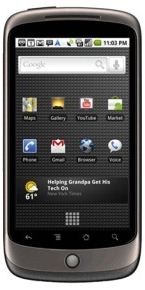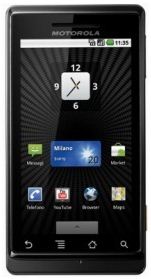Beginnings of Android, smartphone operating system
Mobile phones become small computers, and application development can earn as much, and often more, than on traditional computers.
iPhone apps can make millions of dollars. Webmasters and programmers should consider mobile phones as the primary audience platform of the future. Video from the Nexus One shows that they have nothing to envy computers when it comes to graphics.
"If Google had done nothing, we would be facing a draconian future where one person, one company, one piece of hardware, one supplier would be our only choice. It's a future we don't want.'
This is exactly what Google said during the presentation of Android 2.2, while displaying an image of interest in 1984.
Yet MacIntosh was launched with an advertising campaign on the same subject, a 1984 film. The world is changing!
In response to rumors about Google Phone, Bill Gates said in an interview with the New York Times:
"And as for saying that we can compete in the mobile market when it gets software-rich, I wouldn't consider that."
Who said Bill was a visionary?

Android and its evolution
Google CEO Eric Schmidt said at Mobile World Congress that 60,000 Android phones (Nexus One and other manufacturers) are sold every day.
Google's operating system is the main contender for the iPhone, and its release angered Steve Jobs.
Based on the same type of touch interface, it makes mobile phone use intuitive and fast. The number of apps will soon reach the level of the iPhone, fueled by competitions hosted by Google.
Android 3 was planned for October 2010 and will be reserved for very powerful smartphones.
It will allow you to get a resolution of 1280x760, which actually corresponds to a 22-inch screen !
Manufacturers will no longer need to add additions to the user interface, which has been redesigned, improved and expanded.
Nexus One video running Android.
In Android 4, every aspect of the OS has been improved in this version. An upgrade from Android 2 or 3 is possible, provided that the hardware allows it.
New features include resizable widgets that contain full-fledged applications.
See What's New at Ice Cream Sandwich.
Over time, the system has evolved in terms of its interface, its features, and its backend. The Dalvik virtual machine was replaced by a compiler to speed up applications, and now Java is just one language among others to create them.
Nexus One
The Google mobile phone running the Android operating system was officially announced on January 5, 2010. It was the first device sold by Google, but others will follow, including an electronic tablet now in development.
It was originally made available to Google employees before it went on public sale, and Google uploaded the video to YouTube.
The announced retail price is about €400, and a partnership with French phone provider SFR is planned. In this case, the device will be sold for €150 with a subscription of €50 per month for 24 months.
Technical specifications
- Snapdragon processor clocked at 1 MHz.
- 3.7-inch screen.
- 800x480p resolutions.
- 512 MB of memory.
- 4 GB microSD expansion expandable up to 32 GB.
- Proximity, light sensors and accelerometers.
- 5 megapixel camera with fast shooting. LED flash.
- Voice recognition.
- Operating system Android 2.1.
It is a very thin and light device manufactured by HTC, which already produces an Android mobile phone.
Nexus vs. iPhone
Both devices have similar specifications. The iPhone has 8GB of storage, while the Nexus has a larger screen and a better camera.
Both devices can have 3G depending on the carrier.
With a voice, you can fill in any field with the Nexus One. The iPhone currently has four times as many apps, but that's about to change.
Nexus One is also at least €100 cheaper.
Microsoft criticizes Google's strategy... and launches its own phone

Will the fact that Google is selling its own phone disappoint other manufacturers and encourage them not to use the Android operating system?
It seems that, on the contrary, according to the latest available figures, the opposite effect occurs. For example, Motorola Droid's market share rose from 1% to 13% in December.
Overall, the number of smartphone buyers who intend to use Android increased from 6% to 21% in December 2010.
Looking back in February 2010, we see that more and more manufacturers are announcing mobile models based on Android, so it seems that Google, having offered its own model, has shown that it can successfully compete with its software users (for software).
Microsoft, which also sells hardware, in this case an Xbox game console, but does not compete with products that use its software, believes Google's strategy is flawed.
Robbie Bach, president of games and peripherals, believes that other manufacturers will hesitate to use the Android platform, fearing that Google will take more into account their interests.
It is very, very difficult to do what they do by selling both software and hardware. Google is sending a signal about where they will place their future commitments.
On April 12, 2010, Microsoft released its own Kin smartphone, which has two social media features and a full keyboard. It uses an adapted version of Windows Mobile 7.
Since 2006, Microsoft has also been selling a digital music player competing with the iPod, the Zune, which can connect to the Internet via Wi-Fi and allows you to watch videos. The operating system is derived from Windows CE.
Motorola и Android
On August 15, 2011, CEO Larry Page announced Google's acquisition of Motorola's mobile division for $12.5 billion.
Thus, Google has also become a manufacturer of mobile devices, or rather a designer, since companies such as Apple currently have the products they design manufactured in the East.
But the main goal, and this is mentioned in the announcement of Supercharging Android with Motorola, is to take advantage of the numerous patents of Motorola (24,500 in January 2011), a very old player in the field.
Google will thus be able to intervene against companies such as Apple and Microsoft, which are filing claims for patent infringement (more or less artificial), in order to discourage manufacturers from adopting Android: the company will also be able to sue them.
Therefore, the future of Android seems to be guaranteed by this action. It will remain free and open, it is Google that announces it. And Sony and HTC executives are delighted with the deal. Android saved Motorola by reviving the manufacturer's mobile sales; it seems the opposite is becoming true. Many doubt that Google can continue to supply Android to manufacturers that have become competitors without being tempted to favor its own company. In fact, Google needs an ecosystem, applications, for Android to be interesting to users. So he needs other manufacturers, unless his own products become so popular that they take up more market share, which is unlikely.